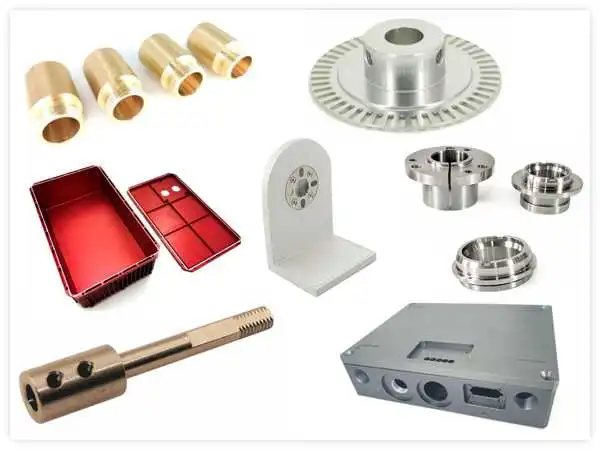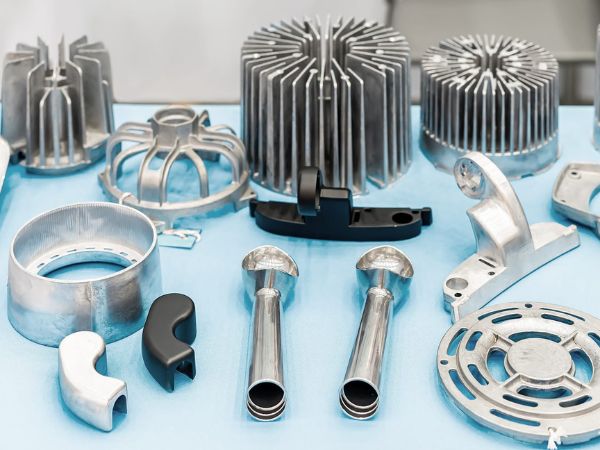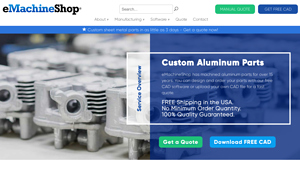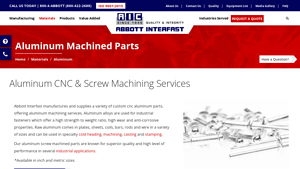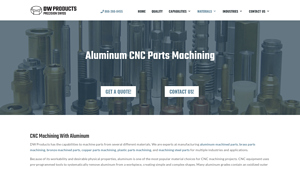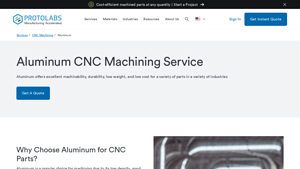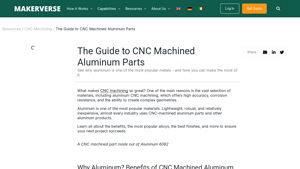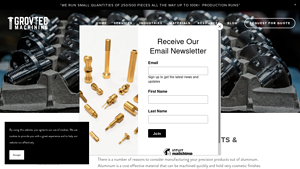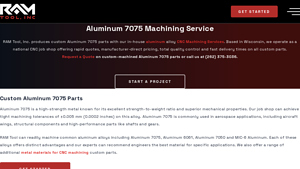Aluminum Machine Parts Guide: Type, Cost, Top List…
Introduction: Navigating the Global Market for aluminum machine parts
In an increasingly interconnected world, sourcing high-quality aluminum machine parts presents both opportunities and challenges for international B2B buyers. One pressing issue many face is navigating the diverse landscape of manufacturers and suppliers who offer a plethora of options in terms of both pricing and quality. This guide aims to demystify the complexities of the global aluminum machine parts market, equipping buyers from regions such as Africa, South America, the Middle East, and Europe—particularly Germany and Saudi Arabia—with essential tools for informed purchasing decisions.
Throughout this comprehensive resource, you will explore various types of aluminum alloys and their specific applications across industries like automotive, aerospace, and construction. We’ll address key factors to consider when vetting suppliers—such as quality assurance, manufacturing capabilities, and compliance with international standards—to ensure you partner with reliable sources. Detailed insights into cost analysis and effective negotiation strategies will also be provided to help you maximize value while minimizing risk.
By empowering you with actionable insights and expert guidance, this guide serves as a critical resource in streamlining your sourcing process for aluminum machine parts. With the right knowledge at your fingertips, you can confidently navigate the global marketplace, select the optimal components for your needs, and foster beneficial long-term relationships with suppliers.
Understanding aluminum machine parts Types and Variations
| Type Name | Key Distinguishing Features | Primary B2B Applications | Brief Pros & Cons for Buyers |
|---|---|---|---|
| Aluminum 6061 | Good mechanical properties, weldable, corrosion-resistant | Automotive, aerospace, industrial parts | Pros: Versatile, cost-effective. Cons: Lower strength compared to some alloys. |
| Aluminum 2024 | High strength-to-weight ratio, excellent fatigue resistance | Aerospace, defense, military applications | Pros: Ideal for critical applications. Cons: Poor corrosion resistance. |
| Aluminum 5052 | High corrosion resistance, malleable, good formability | Marine applications, automotive fuel tanks, railings | Pros: Excellent durability, great for challenging environments. Cons: Higher cost compared to 6061. |
| CNC Machined Parts | Precision-engineered from various aluminum alloys | Various industries including electronics and automotive | Pros: Tailored to specifics, high quality. Cons: Higher upfront costs for custom designs. |
| Cold-Headed Fasteners | Produced through cold heading, strong at high production rates | Automotive and industrial connections | Pros: Strong, high-volumes with fast lead times. Cons: Limited to specific designs. |
What Are the Key Characteristics of Aluminum 6061 Parts?
Aluminum 6061 is one of the most widely used aluminum alloys due to its high mechanical properties and excellent weldability. This alloy is corrosion-resistant and supports various manufacturing methods, making it suitable for a broad range of applications like automotive parts and industrial equipment. Buyers should consider that while 6061 is versatile and cost-effective, its strength may be lower compared to options like 2024, particularly in demanding structural applications.
Why Choose Aluminum 2024 for High-Strength Applications?
Aluminum 2024 is recognized for its exceptional strength-to-weight ratio, making it a preferred choice in aerospace and military sectors where performance under stress is critical. Its properties lend themselves well to high wear and fatigue resistance, but they come with trade-offs in terms of corrosion resistance; thus, buyers must evaluate the need for surface treatments like anodizing. This alloy is often selected for parts like aircraft wings and fuselages.
How Does Aluminum 5052 Stand Out in Marine Applications?
Aluminum 5052 is highly valued for its excellent corrosion resistance, particularly in marine environments where exposure to saltwater is common. Its malleability allows for complex shapes and intricate designs, making it ideal for applications such as fuel tanks and railings. Buyers should weigh the benefits of durability against the higher costs in comparison to other alloys like 6061, especially when manufacturing components that must withstand harsh conditions.
What Advantages Do CNC Machined Aluminum Parts Offer?
CNC machining allows for intricate and precise manufacturing of aluminum parts from various alloys, catering to industries like electronics and automotive. The customization potential enables the production of tailored components that meet specific client specifications, although this may involve higher initial investment costs. Buyers are encouraged to consider the long-term value in terms of performance and fit for their unique applications.
Why Are Cold-Headed Aluminum Fasteners Ideal for High-Volume Production?
Cold-headed fasteners, made from aluminum, are known for their strength and quick production cycles. These parts are particularly advantageous for high-volume manufacturing in automotive and industrial applications, where rapid assembly and reliability are paramount. However, this method limits design flexibility, so it is essential for buyers to ascertain that their requirements align with the capabilities of cold heading.
Key Industrial Applications of aluminum machine parts
| Industry/Sector | Specific Application of aluminum machine parts | Value/Benefit for the Business | Key Sourcing Considerations for this Application |
|---|---|---|---|
| Aerospace | Aircraft structural components | Reduces weight, enhances fuel efficiency | Ensure compliance with aerospace standards; focus on quality certification (e.g., ISO 9001) and material traceability. |
| Automotive | Engine and chassis components | Enhances performance and reduces overall vehicle weight | Look for suppliers offering specialization in lightweight alloys and extensive machining capabilities. Verify local sourcing capabilities for rapid delivery. |
| Electrical Equipment | Electrical enclosures and heat sinks | High thermal conductivity ensures performance | Seek vendors with experience in producing components that meet electrical safety standards; consider environmental conditions in manufacturing. |
| Construction | Window frames and structural elements | Increases durability with reduced corrosion risks | Prioritize suppliers skilled in extrusion and finishing processes; evaluate cost-efficiency for large-scale projects. |
| Marine | Boat hulls and deck fittings | Lightweight yet strong, optimizing hydrodynamics | Select suppliers with marine-grade certifications; assess capability in producing custom shapes and designs. |
How Are Aluminum Machine Parts Utilized in the Aerospace Sector?
Aluminum machine parts play a pivotal role in aerospace, where they are used in aircraft structural components. These parts are essential for reducing overall weight, significantly improving fuel efficiency. International buyers from regions like Europe—especially Germany, where strict regulatory standards exist—must ensure that their suppliers comply with aerospace industry regulations. Comprehensive quality certifications and rigorous testing protocols are essential for maintaining safety and performance.
What Are the Applications of Aluminum Parts in the Automotive Industry?
In the automotive sector, aluminum is increasingly used for engine components, chassis parts, and other lightweight structures. This application not only enhances vehicle performance but also aids in meeting emission regulations by reducing weight. Buyers, particularly in South America and the Middle East, should consider suppliers with robust engineering capabilities and quick turnaround times to keep pace with evolving automotive technologies. Cost efficiency is crucial for buyers looking to scale production.
Where Do We See Aluminum Machine Parts in Electrical Equipment?
Aluminum machine parts are also fundamental in the electrical equipment industry, primarily for electrical enclosures and heat sinks. These components benefit from the metal’s high thermal conductivity, which is vital for ensuring efficient operation and heat dissipation. When sourcing, international businesses must focus on suppliers that understand electrical safety regulations and can customize parts to meet specific voltage requirements.
In What Ways Are Aluminum Parts Used in Construction?
The construction industry utilizes aluminum machine parts for applications such as window frames and other structural elements. The metal’s corrosion resistance and strength make it ideal for long-term use, particularly in diverse climates. For buyers in Africa and the Middle East, selecting suppliers that can offer aluminum extrusions and surface finishing options is critical. Evaluating a supplier’s capacity for large orders is also essential as building projects require consistency and reliability.
How Do Aluminum Components Benefit Marine Applications?
In the marine industry, aluminum parts are widely used for constructing boat hulls and deck fittings due to their lightweight nature, which enhances hydrodynamics. The combination of strength and resistance to saltwater corrosion provides a significant advantage. It is vital for international buyers to look for manufacturers with marine-grade certifications and experience in producing custom marine components. Understanding local regulations and environmental conditions can also affect the sourcing decision.
3 Common User Pain Points for ‘aluminum machine parts’ & Their Solutions
Scenario 1: Inconsistent Quality of Aluminum Parts
The Problem: A leading automotive manufacturer experiences frequent production delays due to inconsistent quality in aluminum machine parts received from various suppliers. Parts either do not meet the required tolerances or show varying degrees of surface finish, leading to assembly issues and unforeseen costs in rework. This inconsistency creates frustration among engineers who depend on reliable components for timely deliveries and quality assurance.
The Solution: To mitigate this problem, buyers should develop clear specifications for aluminum parts, including stringent quality assurance measures. Engaging with suppliers who offer quality certifications, like ISO 9001, ensures that their manufacturing processes align with best practices. Additionally, initiating a collaborative design phase with suppliers can foster better communication, allowing for a mutual understanding of required tolerances and quality expectations. Using digital platforms to share 3D CAD designs can minimize misinterpretations and streamline feedback loops. Establishing a routine for supplier audits further helps maintain consistent quality over time.
Scenario 2: Challenges in Selecting the Right Aluminum Alloy
The Problem: A B2B buyer is tasked with sourcing aluminum parts for a new aerospace project but is overwhelmed by the variety of aluminum alloys available. Each alloy has unique properties, such as strength, weight, and corrosion resistance, which complicates the selection process. Making the wrong choice can lead to project delays and increased material costs, greatly affecting the project’s budget and timelines.
The Solution: To effectively navigate the selection of aluminum alloys, buyers should first conduct a comprehensive analysis of the application requirements and environmental conditions the aluminum parts will face. Key factors to consider include weight limitations, required strength, and exposure to corrosive elements. Making use of standardized grading charts, such as those provided by the Aluminum Association, can simplify the decision-making process. Furthermore, collaborating with material engineers or experienced manufacturers can provide insights into which alloys, such as 6061 for general applications or 7075 for high-stress environments, are best suited for specific uses in aerospace. By conducting material testing and evaluating prototype parts, buyers can gain practical understanding before bulk purchasing.
Scenario 3: Supply Chain Disruptions Affecting Lead Times
The Problem: An electronics manufacturer is facing significant lead time issues due to supply chain disruptions in acquiring aluminum machine parts, leading to production bottlenecks. Many suppliers are unable to meet demands due to global logistic challenges, which results in increased costs and missed product launch deadlines. This impacts not only profitability but also the company’s reputation with clients.
The Solution: To address supply chain issues, it is crucial for buyers to diversify their supplier base rather than relying on a single source for aluminum components. Building relationships with suppliers across different regions, including local suppliers in Africa and South America, can stabilize supply lines and reduce dependency on international transport. Establishing a just-in-time inventory approach can help manage stock levels more efficiently while ensuring materials are available when needed. Additionally, investing in transparent supply chain technologies will enable real-time tracking and foster open communication with suppliers. Continuous monitoring of market trends can provide advance warnings of potential disruptions, allowing buyers to adjust sourcing strategies proactively.
Strategic Material Selection Guide for aluminum machine parts
How to Choose the Right Aluminum Alloy for Machine Parts
Selecting the appropriate aluminum material for machine parts is crucial for optimizing performance, cost-efficiency, and longevity. Here, we analyze several aluminum alloys that are commonly used in industrial applications, focusing on their properties, advantages, and limitations, while considering the unique needs of international buyers, especially from Africa, South America, the Middle East, and Europe.
What are the Key Properties of Aluminum Alloy 6061?
Aluminum Alloy 6061 is one of the most widely used aluminum alloys in the machining of parts due to its exceptional mechanical properties. It offers an excellent strength-to-weight ratio, allowing parts to maintain structural integrity under variable conditions. The alloy also has good corrosion resistance and can withstand moderate stress. It can perform well in temperature ranges from -40°F to 200°F.
Pros:
– High corrosion resistance
– Good weldability
– Versatile applications across various industries
Cons:
– Moderate machining costs
– Requires post-production treatments for specific applications
For international buyers, 6061 aligns with many standards such as ASTM B221 in the US and EN 573 in Europe, making it a reliable option for projects that demand compliance.
How Does Aluminum Alloy 7075 Compare in Performance?
Aluminum Alloy 7075 is known for its superior strength, especially under extreme stresses, making it a preferred choice in aerospace and military applications. While it has excellent fatigue resistance, its machinability is average compared to other alloys like 6061.
Pros:
– High strength-to-weight ratio
– Excellent fatigue resistance
– Suitable for airframe structures
Cons:
– Expensive relative to other aluminum alloys
– Poor corrosion resistance, requiring additional treatment
International buyers should be mindful of compliance with strict aerospace standards like AS9100 for the use of 7075, particularly in the Middle East and Europe, where safety standards are tightly regulated.
What Advantages Does Aluminum Alloy 2024 Offer?
Aluminum Alloy 2024 is particularly well-suited for use where strength and fatigue resistance are critical. This alloy is often utilized in applications that require high strength, such as aircraft structures, although it has limited corrosion resistance.
Pros:
– Excellent strength and fatigue resistance
– Commonly used in aerospace applications
Cons:
– Poor corrosion resistance; requires protective coatings
– Challenging to machine due to high strength
For global buyers, understanding the regional variations in applicable standards like DIN 50049 or ASTM B918 can ensure compliance and product longevity when employing 2024 in projects.
How Does Aluminum Alloy 5052 Fit into the Landscape?
Aluminum Alloy 5052 is favored for its superb forming capabilities, making it highly popular in sheet metal fabrication. It possesses excellent corrosion resistance properties, especially in marine environments, making it ideal for applications ranging from fuel tanks to marine vessels.
Pros:
– Exceptional corrosion resistance
– Easy to form and fabricate
Cons:
– Lower strength compared to 6061 and 7075
– Cost may increase with complex shapes.
International buyers need to ensure that parts produced with 5052 comply with regulations such as the International Maritime Organization (IMO) standards for marine applications, especially in South America and Africa, where local regulations can vary widely.
Summary Table of Aluminum Alloys for Machine Parts
| Material | Typical Use Case for aluminum machine parts | Key Advantage | Key Disadvantage/Limitation | Relative Cost (Low/Med/High) |
|---|---|---|---|---|
| Aluminum 6061 | General-purpose industrial parts | High corrosion resistance, versatility | Moderate machining costs | Med |
| Aluminum 7075 | High-performance aerospace components | Superior strength-to-weight ratio | Poor corrosion resistance | High |
| Aluminum 2024 | Aircraft structures requiring high strength | Excellent fatigue resistance | Challenging to machine | High |
| Aluminum 5052 | Marine and fuel tank applications | Exceptional corrosion resistance | Lower strength compared to others | Med |
This strategic material selection guide provides essential insights for international B2B buyers, enabling informed decision-making when sourcing aluminum machine parts that best fit their specific needs.
In-depth Look: Manufacturing Processes and Quality Assurance for aluminum machine parts
Understanding Key Manufacturing Processes for Aluminum Machine Parts
When investing in aluminum machine parts, it is crucial for B2B buyers to comprehend the intricacies of manufacturing processes, as well as the quality assurance measures that ensure product reliability. The production of aluminum components typically involves several key stages: material preparation, forming, assembly, and finishing. Each stage employs specific techniques that can significantly impact the final product’s quality and performance.
What are the Main Stages of Aluminum Parts Manufacturing?
How is Material Preparation Conducted?
The initial step in the manufacturing process is material preparation, which involves the selection and sourcing of high-quality aluminum alloys. Buyers should look for suppliers who provide detailed information about the grades used, such as 6061, 6063, 7075, and 2024, as each offers varying properties suited for specific applications. After material selection, the raw aluminum may undergo cleaning or surface treatments to remove contaminants that could affect later machining processes.
Which Forming Techniques are Commonly Used?
Once prepared, the aluminum is subjected to various forming techniques, primarily machining, to achieve the desired shape and precision. Common methods include:
- CNC Milling: Used for producing complex geometries with tight tolerances. This method employs rotating tools and works effectively for both 2D and 3D features.
- CNC Turning: Particularly efficient for creating cylindrical parts. The workpiece rotates while cutting tools are fed into it, allowing for precise control over dimensions.
- Waterjet Cutting: This method uses a high-pressure stream of water mixed with abrasives to cut through aluminum sheets quickly and cleanly, making it ideal for intricate designs.
- EDM (Electrical Discharge Machining): A process that uses electric sparks to create parts with complex designs, especially useful for high-precision applications.
The chosen methods need to reflect the specifications outlined in CAD files, ensuring that all dimensions and mechanical properties align with industry standards.
What is the Assembly Process Like?
After individual components have been machined, they may require assembly. This could include integrating various machined parts into a final component, using techniques such as welding, bolting, or riveting. During this stage, buyers should inquire about the assembly capabilities of suppliers, as well as their adherence to international assembly standards, particularly if parts will be used in critical sectors like aerospace or automotive.
How is Finishing Applied to Enhance Quality?
Following assembly, finishing processes are vital to enhance the appearance and durability of aluminum components. Common finishing techniques include:
- Anodizing: This electrochemical process increases corrosion resistance and allows for aesthetic coloring.
- Powder Coating: Provides a robust protective layer that enhances wear resistance and visual appeal.
- Polishing: Used to create a mirror-like surface finish, enhancing reflectivity and, in some cases, corrosion resistance.
Selecting the right finishing method is crucial for meeting both aesthetic and functional requirements.
What Quality Assurance Standards are Essential in Aluminum Manufacturing?
Why are International Standards Important?
Quality assurance in manufacturing aluminum machine parts is paramount for international buyers. Adherence to relevant standards, such as ISO 9001, lays the foundation for quality management systems that enhance product consistency and customer satisfaction. Additionally, industry-specific certifications may include CE for products marketed in Europe or API certifications for components in the oil and gas sector.
What are the Key Quality Control Checkpoints?
Quality Control (QC) checkpoints are divided into several critical stages within the manufacturing process:
-
Incoming Quality Control (IQC): This stage involves examining raw materials upon arrival to ensure they meet specifications. It might incorporate tests such as tensile strength and chemical composition analysis.
-
In-Process Quality Control (IPQC): During manufacturing, ongoing inspections take place to ensure processes are being adhered to and any deviations from specifications are promptly addressed.
-
Final Quality Control (FQC): At this stage, finished products undergo comprehensive testing to validate their performance against design specifications. This often includes dimensional checks, mechanical property assessments, and functionality testing.
How Can B2B Buyers Verify Part Quality and Supplier QC Practices?
B2B buyers can implement several strategies to ascertain the quality of suppliers’ products and compliance with QC practices:
-
Audits: Regular auditing of the manufacturing facility allows buyers to assess compliance with quality standards and manufacturing capabilities.
-
Quality Reports: Requesting detailed quality reports, including ISO certifications, testing results, and process controls, can provide insight into the supplier’s adherence to best practices.
-
Third-party Inspection: Involving independent inspectors can offer an unbiased evaluation of the manufacturing processes and final products, assuring compliance with international standards.
What are the Nuances of QC for International Buyers?
For international buyers, particularly from Africa, South America, the Middle East, and Europe, it is essential to understand that quality requirements can fluctuate significantly. For example, the regulatory environment in Europe may impose stricter testing and certification standards than other regions. Buyers should familiarize themselves with local regulations and industry practices to align their quality expectations with each supplier’s capacities.
In summary, comprehending the complexities of aluminum parts manufacturing and robust quality assurance processes enables B2B buyers to make informed decisions about their suppliers. This knowledge not only aids in ensuring product reliability and compliance but also fosters strong supplier relationships that can drive future success in their industries.
Practical Sourcing Guide: A Step-by-Step Checklist for ‘aluminum machine parts’
Introduction
Sourcing aluminum machine parts requires careful consideration to ensure quality, reliability, and cost-effectiveness. This checklist provides international B2B buyers with a step-by-step approach to successfully procure the right aluminum components that align with their technical specifications and operational needs.
Step 1: Define Your Technical Specifications
Before initiating the sourcing process, clearly define your requirements for the aluminum parts. This includes dimensions, tolerances, alloy specifications, and any surface treatment needed. A detailed specification sheet helps potential suppliers understand your needs, reducing the risk of misunderstandings and ensuring that you receive products that meet your expectations.
Step 2: Research Suitable Materials
Understanding the properties of different aluminum alloys is crucial for selecting parts that will perform well in your application. For example, Aluminum 6061 is known for its versatility and strength, making it suitable for automotive and aerospace components. Assess your application’s demands—consider factors such as weight, corrosion resistance, and machinability—to choose the most appropriate alloy.
Step 3: Evaluate Potential Suppliers
Thoroughly vet suppliers before making a commitment. Look for credentials such as ISO certification and experience in manufacturing aluminum parts. Request company profiles, feedback from existing clients, and evidence of their ability to meet your volume and quality requirements.
Step 4: Request Prototype Samples
Once you have identified potential suppliers, request prototype samples of the parts you need. This step is critical as it allows you to assess the quality, precision, and finish of the final product. Evaluate their response times and flexibility in accommodating adjustments based on your feedback, which indicates their customer service quality.
Step 5: Discuss Pricing and Payment Terms
Establish transparent discussions regarding pricing structures and payment terms early in the sourcing process. Seek quotes from multiple suppliers to compare costs but be cautious of choosing solely based on price. Inquire about bulk discounts, shipping charges, and payment options, which can significantly impact your overall total cost.
Step 6: Check for Compliance and Certifications
Ensure that potential suppliers comply with local and international standards related to quality, safety, and environmental impact. Certifications, such as RoHS or REACH, can be indicative of a supplier’s commitment to quality. This step is essential, especially when considering the increasing regulatory scrutiny in various regions related to manufacturing practices.
Step 7: Establish a Clear Communication Channel
Effective communication is vital throughout the sourcing process. Set expectations for regular updates and establish preferred communication methods for discussing design changes, lead times, and any potential issues. A responsive and proactive communication channel can reduce delays and enhance collaboration between you and the supplier.
By following this checklist, B2B buyers can streamline the sourcing process for aluminum machine parts, ensuring that they secure high-quality components that meet their specifications while fostering successful supplier relationships.
Comprehensive Cost and Pricing Analysis for aluminum machine parts Sourcing
When it comes to sourcing aluminum machine parts, understanding the comprehensive cost structure is essential for making informed purchasing decisions. Below is an analysis of the various cost components, price influencers, and tips for buyers, particularly those engaging in international trade from regions such as Africa, South America, the Middle East, and Europe.
What Are the Key Cost Components for Aluminum Machine Parts?
Materials: The cost of aluminum itself varies based on the market price of raw materials and the specific alloy being used. Popular aluminum alloys, such as 6061, 7075, and 2024, exhibit different strengths and machinabilities, influencing their price points. Buyers should stay updated on aluminum market fluctuations to forecast material costs accurately.
Labor: Labor costs can differ significantly based on the manufacturing location. For instance, labor is usually less expensive in South America or parts of Africa than in Europe or North America. However, the skill level and experience reflected in the labor can affect the quality of the final product, justifying higher costs in developed markets.
Manufacturing Overhead: This includes fixed and variable costs related to factory operations, utilities, and administrative expenses. Manufacturers may allocate overhead differently, and this can influence pricing. Buyers should inquire about how overhead costs are determined by their suppliers.
Tooling: Tooling costs encompass the expenses involved in producing the necessary molds, dies, and other equipment for manufacturing aluminum parts. Initial tooling can be costly, particularly for custom components, but these costs may be amortized over larger production runs.
Quality Control (QC): Effective quality control processes ensure that parts meet specified standards and requirements. Quality inspections add to the overall cost but are essential for high-stakes industries (e.g., aerospace, automotive) where failure is not an option.
Logistics: Transportation costs and logistics should not be overlooked. Costs can vary based on shipping methods, distances, and the Incoterms agreed upon in the contract. For international buyers, customs duties and import tariffs also factor into the total cost.
Margin: Manufacturers and suppliers typically apply a markup or profit margin on the base costs to ensure profitability. Understanding the industry standard margins can help buyers negotiate pricing effectively.
What Factors Influence Pricing for International Buyers?
Volume and Minimum Order Quantities (MOQ): Generally, larger orders lead to discounts due to economies of scale. However, suppliers often set MOQs, influencing the pricing structure. Buyers must assess their demand and order quantities accordingly to maximize savings.
Specifications and Customization: Custom parts often incur higher prices due to the added complexity of design and manufacturing. Buyers should provide clear specifications to avoid unnecessary costs and ensure the best pricing.
Quality Certifications: Certain industries require components to meet specific quality standards and certifications (e.g., ISO, AS9100). Suppliers possessing these certifications may charge a premium due to the testing and quality assurance processes inflected in their operations.
Supplier Factors: The supplier’s reputation, capacity, and experience in manufacturing aluminum parts can significantly influence pricing. Engaging with a reputable supplier might come at a higher cost, but the reliability and quality assurance often justify this investment.
Incoterms: Purchasing terms defined by Incoterms can impact the overall pricing structure, as they dictate who bears the responsibilities regarding freight charges, insurance, and customs clearance. Familiarizing oneself with Incoterms is essential for managing costs accurately.
What Tips Can Buyers Use to Negotiate Costs Effectively?
To achieve cost efficiency, B2B buyers should adopt a strategic approach:
-
Conduct a Total Cost of Ownership (TCO) analysis: Look beyond the purchase price to include maintenance, operation, and long-term reliability costs into your calculations. This will provide a clearer picture of the overall investment.
-
Negotiate Terms: Be proactive in negotiations by discussing volume discounts, flexible MOQs, and payment terms. Building a long-term relationship with suppliers may yield better pricing options over time.
-
Educate Yourself on Pricing Nuances: Different regions have varying market dynamics; understanding local production capabilities and costs can empower buyers in negotiations.
-
Seek Multiple Quotes: Expanding your supplier search and obtaining multiple quotes will create competitive pressure, potentially leading to cost reductions.
Understanding these facets of aluminum machine parts sourcing not only allows international buyers to make more informed purchasing decisions but can ultimately enhance their profitability and operational success.
Alternatives Analysis: Comparing aluminum machine parts With Other Solutions
When considering machine parts, it’s essential for B2B buyers to explore various materials and manufacturing processes to determine the most suitable option for their applications. Aluminum has gained immense popularity due to its unique characteristics, but alternatives exist that may be more suitable depending on specific project requirements. This section compares aluminum machine parts against alternative solutions such as stainless steel and plastic composites, offering insights that guide decision-making.
| Comparison Aspect | Aluminum Machine Parts | Stainless Steel Parts | Plastic Composites |
|---|---|---|---|
| Performance | High strength-to-weight ratio; corrosion-resistant; excellent machinability. | Extremely durable and strong; good corrosion resistance; can withstand high temperatures. | Excellent for noise and vibration dampening; lightweight; can be molded into complex shapes. |
| Cost | Generally economical; initial machining costs are low, but specific alloys can be more expensive. | Higher material costs; machining can also be expensive due to hardness. | Typically low to moderate costs; however, some specialty composites can be costly. |
| Ease of Implementation | Straightforward machining and fabrication processes; multiple alloy options available. | Requires specialized machining techniques; slower processing times compared to aluminum. | Easy to mold and shape; ideal for rapid prototyping; may require specialized handling. |
| Maintenance | Minimal maintenance due to corrosion resistance; surface treatments enhance lifespan. | May require regular maintenance in corrosive environments; can be heavier which affects operation. | Generally low maintenance; UV exposure can degrade some materials over time. |
| Best Use Case | Ideal for automotive, aerospace, and structural components that require lightweight solutions. | Best for applications needing high heat resistance and structural integrity (e.g., industrial equipment). | Suited for non-structural applications, enclosures, or cases where weight reduction is critical. |
What Are the Benefits and Drawbacks of Stainless Steel Parts?
Stainless steel is renowned for its durability and corrosion resistance, making it a reliable choice for demanding environments. Its strength is advantageous in applications requiring robustness at high temperatures. However, stainless steel’s hardness can complicate machining processes, often leading to increased labor and machinery wear costs. Moreover, the initial material costs are typically higher than aluminum, which can affect overall project budgets.
How Do Plastic Composites Compare to Aluminum Machine Parts?
Plastic composites present a compelling alternative, especially for lightweight applications and designs that are complex. They can be manufactured quickly via molding techniques, which reduces lead times for prototypes. Their ability to absorb vibrations makes them ideal for applications in the automotive and audio industries. On the downside, some composites may lack the structural integrity of metals and can degrade under UV exposure, limiting their long-term applicability in outdoor settings.
Conclusion: How Can B2B Buyers Select the Right Solution for Their Needs?
Choosing the right material for machine parts hinges on understanding the specific needs of your application. Aluminum parts offer a blend of lightweight efficiency, economical manufacturing processes, and good corrosion resistance, making them suitable for a variety of industries. However, stainless steel is preferable for applications demanding maximum strength and durability under extreme conditions, while plastic composites shine in lightweight, complex designs requiring rapid fabrication.
B2B buyers should carefully assess operational demands, environmental conditions, and cost constraints of their projects before making a selection. Collaborating with material suppliers and manufacturers can provide further insights and guidance, ensuring that the chosen solution aligns with both current needs and future capabilities.
Essential Technical Properties and Trade Terminology for aluminum machine parts
Understanding the technical specifications and common terminology related to aluminum machine parts is crucial for international B2B buyers. This knowledge can lead to better decision-making when selecting materials and negotiating contracts. Below are several key properties and terms that are essential in this domain.
What Are the Critical Specifications for Aluminum Machine Parts?
1. Material Grade
Material grade refers to the specific alloy composition of aluminum, which determines its physical and mechanical properties. Common aluminum alloys include 6061, 5052, and 7075. Knowing the proper grade is important because it influences factors such as strength, weight, and corrosion resistance, ultimately affecting the performance and lifespan of the parts in various applications.
2. Tolerance
Tolerance defines the allowable variation in dimensions of machined components. Tighter tolerances lead to higher precision but may also increase production costs. In industries like aerospace and automotive, where performance and safety are paramount, understanding tolerance specifications helps ensure that parts fit correctly and function as intended.
3. Surface Finish
The surface finish of aluminum parts impact their appearance and functionality. Options like anodizing or powder coating not only enhance aesthetics but also improve corrosion resistance and wear properties. Choosing the right finish is essential for maintaining the integrity and extending the longevity of components in harsh environments.
4. Strength-to-Weight Ratio
This critical property indicates how much load an aluminum part can bear relative to its weight. A high strength-to-weight ratio is advantageous in sectors such as aerospace and automotive, where minimizing weight while maintaining strength is key for fuel efficiency and performance. Understanding this ratio aids in material selection for specific applications.
5. Machinability
Machinability describes how easily a material can be machined to produce precise parts. Aluminum is favored in manufacturing for its excellent machinability, allowing for complex designs while maintaining cost-effectiveness. Awareness of machinability can guide buyers in selecting parts that meet manufacturing requirements without incurring unnecessary expenses.
6. Corrosion Resistance
Aluminum naturally forms an oxide layer that protects against corrosion, making it suitable for diverse applications, particularly in marine and industrial settings. Knowledge of corrosion resistance is essential for buyers to ensure that the aluminum parts will withstand the environments they are placed in, minimizing maintenance and replacement costs.
What Are Common Trade Terminology Related to Aluminum Parts?
1. OEM (Original Equipment Manufacturer)
This term refers to companies that produce parts and products that can be marketed under another firm’s brand. In the context of aluminum parts, understanding OEM helps buyers identify suppliers capable of delivering products meeting their specifications and quality standards.
2. MOQ (Minimum Order Quantity)
MOQ indicates the smallest number of units a supplier is willing to process in an order. This allows buyers to budget appropriately and ensures suppliers meet profitability thresholds. Knowing MOQ helps companies gauge the feasibility of bulk purchases versus smaller, more frequent orders.
3. RFQ (Request for Quotation)
An RFQ is a document sent to suppliers to request pricing and terms for specific quantities of goods. Utilizing RFQs is essential in sourcing aluminum parts, as they allow buyers to compare offers systematically and make informed procurement decisions based on price and service.
4. Incoterms
Incoterms are standardized international trade terms that define the responsibilities of buyers and sellers in shipping goods. Familiarity with these terms, like FOB (Free on Board) or CIF (Cost, Insurance, and Freight), protects parties in their shipping agreements, ensuring clarity on responsibilities and costs involved.
5. Secondary Processing
This term encompasses additional operations performed on aluminum parts post-machining, such as anodizing, painting, or assembling. Understanding secondary processing options allows buyers to refine their sourcing strategies and decide on processes that align with their quality and performance requirements.
6. Lean Manufacturing
Lean manufacturing is a production practice focused on minimizing waste while maximizing productivity. For B2B buyers, sourcing aluminum parts through lean manufacturing methods can lead to reduced costs and shorter lead times, enhancing overall supply chain efficiency.
Equipping oneself with this knowledge can lead to more strategic purchases, suitable partnerships, and ultimately, a competitive edge in various industries reliant on aluminum components.
Navigating Market Dynamics and Sourcing Trends in the aluminum machine parts Sector
What Are the Current Trends Shaping the Aluminum Machine Parts Market?
The global aluminum machine parts market is experiencing robust growth driven by several key trends. As countries focus on sustainable manufacturing, the demand for lightweight materials like aluminum, which possess excellent strength-to-weight ratios, continues to rise. Particularly in industries such as automotive and aerospace, where fuel efficiency is paramount, aluminum parts are increasingly favored. For B2B buyers in regions like Africa, South America, the Middle East, and Europe, understanding local market dynamics is crucial. For instance, Europe, particularly Germany, places strong emphasis on advanced manufacturing technologies and automation, highlighting the importance of sourcing parts that can integrate with modern production systems.
Emerging technologies, such as Industry 4.0, are revolutionizing how aluminum machine parts are sourced and produced. Advanced CNC machining and additive manufacturing offer unprecedented precision and customization options, enabling businesses to respond quickly to market demands. Moreover, digital sourcing platforms are enhancing transparency and accessibility, allowing international buyers to connect with manufacturers globally. This shift towards digitization is making it easier for companies in remote areas to tap into state-of-the-art technologies. As manufacturers increasingly offer services such as real-time tracking and quality assurance, buyers have the ability to better gauge product reliability and performance from the outset.
How Is Sustainability and Ethical Sourcing Influencing Aluminum Machine Parts Procurement?
Sustainability is no longer just a buzzword but a critical focus for B2B buyers seeking aluminum machine parts. The environmental impact of aluminum production can be significant, particularly in terms of energy consumption and greenhouse gas emissions. Consequently, many companies are adopting ethical sourcing practices, prioritizing suppliers who implement sustainable manufacturing techniques. This includes using recycled aluminum, which not only reduces environmental footprint but also lowers costs in many cases.
Certifications such as ISO 14001 (Environmental Management) and responsible sourcing initiatives are becoming essential for businesses committed to sustainability. Buyers are increasingly looking for partners whose practices align with their environmental values, thus fostering supply chain relationships built on trust and accountability. Furthermore, the adoption of innovative materials, like aluminum alloys with improved recyclability, is gaining traction, appealing to environmentally conscious buyers across regions. This reflects a broader trend where the demand for ‘green’ certifications and materials is influencing purchasing decisions, further driving the need for suppliers to demonstrate their commitment to ethical practices.
What Is the Historical Context of the Aluminum Machine Parts Market?
Aluminum has played a transformative role in manufacturing since its discovery in the late 19th century, becoming widely used in the industry following its commercial production in the early 20th century. Initially praised for its lightweight and malleability, it quickly found applications across diverse sectors, including automotive and aerospace. The introduction of aluminum alloys in the mid-20th century further expanded its applicability, significantly enhancing its strength and resistance to corrosion.
As manufacturing technologies evolved, so did the processes for shaping and machining aluminum. With the advent of CNC machining and other high-precision techniques in recent decades, the production of aluminum machine parts has become faster, more cost-effective, and adaptable to complex designs. This historical background is vital for B2B buyers to understand the journey of aluminum as a material and its growing relevance in contemporary manufacturing practices. As industries continue to innovate, aluminum remains a cornerstone of efficient and sustainable production.
Frequently Asked Questions (FAQs) for B2B Buyers of aluminum machine parts
-
How do I choose the right aluminum alloy for my project?
When selecting an aluminum alloy, consider the specific mechanical properties required for your application. Common alloys include 6061, known for its versatility and good weldability; 2024, recognized for high strength; and 5052, which offers excellent corrosion resistance. It’s also beneficial to factor in the intended use (e.g., automotive, aerospace) and any environmental influences, such as exposure to saltwater or chemicals. Consulting with suppliers on the best alloy for your application, and requesting samples, can help ensure optimal performance. -
What are the common applications for aluminum machine parts?
Aluminum machine parts are widely utilized across several industries due to their lightweight nature and high strength-to-weight ratio. Common applications include components for the automotive, aerospace, and electronics sectors. Specific uses range from automotive frames and engine parts to aircraft structures and electronic enclosures. Additionally, aluminum parts are ideal for manufacturing fasteners and complex shapes in industrial machinery, making them versatile for different forms of manufacturing and design needs. -
What customization options are available for aluminum parts?
Most manufacturers offer numerous customization options, including different machining methods (CNC milling, turning), surface finishes (anodizing, powder coating), and alloy selection. You can also request specific dimensions, tolerances, and even prototype testing to ensure the part meets your requirements. Additionally, many B2B suppliers will allow for unique designs or modifications based on your specifications, enabling you to align the components closely with your operational needs or aesthetics. -
Are there minimum order quantities (MOQs) for aluminum machine parts?
Minimum order quantities can vary widely among suppliers, typically depending on the complexity of the part and the manufacturing process. Some manufacturers may have no MOQs, particularly for custom parts, while others may require a minimum order to optimize costs. When sourcing internationally, it’s essential to discuss MOQs upfront to avoid unexpected expenses and ensure you’re able to meet your demand efficiently. -
What payment terms should I expect when sourcing aluminum parts internationally?
Payment terms in international trade can vary significantly depending on the supplier and jurisdiction. Common terms include upfront payment, a deposit plus balance upon delivery, or letters of credit. Some suppliers may offer flexible payment options depending on your order volume and established relationship. Always review and negotiate the payment terms early in the sourcing process to mitigate any potential transaction risks and ensure financial predictability. -
How can I ensure the quality of aluminum machine parts?
To ensure high-quality aluminum parts, consider suppliers that have robust quality assurance (QA) processes in place. Request certifications such as ISO 9001 or AS9100, which indicate adherence to quality standards. Additionally, inquire about their material testing methods and whether they provide third-party inspection services. Before placing large orders, obtaining samples for evaluation can also be an effective way to assess quality and establish trust in your supplier’s capability. -
What logistics considerations should I keep in mind when importing aluminum parts?
When importing aluminum parts, logistics play a crucial role in ensuring timely delivery and managing costs. Consider shipping methods (air freight for speed vs. sea freight for cost-effectiveness), customs duties, and taxes applicable to your region. Engaging a reliable freight forwarder experienced in international trade can ease the process, as they will help you navigate customs regulations and documentation. Establish a clear timeline to accommodate production and shipping schedules for efficient inventory management. -
How can I vet and select reliable suppliers for aluminum components?
To vet suppliers, consider performing due diligence by checking their business credentials, quality certifications, and customer testimonials. It’s beneficial to request references and case studies to gauge their experience in your specific industry. Visiting the manufacturing facility, if possible, can provide first-hand insights into their production capabilities and quality control processes. Additionally, engaging with multiple suppliers through the request for quotes (RFQs) allows you to compare pricing, lead times, and service offerings effectively.
Important Disclaimer & Terms of Use
⚠️ Important Disclaimer
The information provided in this guide, including content regarding manufacturers, technical specifications, and market analysis, is for informational and educational purposes only. It does not constitute professional procurement advice, financial advice, or legal advice.
While we have made every effort to ensure the accuracy and timeliness of the information, we are not responsible for any errors, omissions, or outdated information. Market conditions, company details, and technical standards are subject to change.
B2B buyers must conduct their own independent and thorough due diligence before making any purchasing decisions. This includes contacting suppliers directly, verifying certifications, requesting samples, and seeking professional consultation. The risk of relying on any information in this guide is borne solely by the reader.
Top 7 Aluminum Machine Parts Manufacturers & Suppliers List
1. eMachineShop – Custom CNC Aluminum Parts
Domain: emachineshop.com
Registered: 1999 (26 years)
Introduction: Custom CNC Aluminum Parts Machining Service, 15+ years of experience, Free CAD software for designing or uploading CAD files, Free shipping in the USA, No minimum order quantity, 100% quality guarantee. Properties of aluminum: lightweight, non-magnetic, excellent corrosion resistance, high strength-to-weight ratio, good heat and electrical conductivity, easily machined. Common aluminum alloys offe…
2. Abbott Interfast – Custom CNC Aluminum Parts
Domain: aicfast.com
Registered: 2012 (13 years)
Introduction: Aluminum CNC & Screw Machining Services – Custom CNC Aluminum Parts. Abbott Interfast offers a variety of custom CNC aluminum parts and aluminum machining services. Aluminum alloys are used for industrial fasteners due to their high strength to weight ratio and anti-corrosive properties. Raw aluminum is available in plates, sheets, coils, bars, rods, and wire. Key aluminum grades include 2011 (hig…
3. DW Products – Custom Aluminum CNC Machining
Domain: dwproducts.com
Registered: 2005 (20 years)
Introduction: DW Products offers CNC machining services for aluminum parts, specializing in the manufacturing of custom machined aluminum components. Aluminum is favored for its workability, corrosion resistance, unique properties, and high machinability compared to denser materials such as steel. The company uses advanced CNC equipment capable of producing complex designs in various production runs. Key advant…
4. Proto Labs – Aluminum CNC Machining Service
Domain: protolabs.com
Registered: 2006 (19 years)
Introduction: Aluminum CNC Machining Service for custom parts with cost-efficient machined parts at any quantity. Key benefits include excellent machinability, high strength and hardness, heat tolerance, corrosion resistance, electrical conductivity, overall versatility, and low cost. Common applications in automotive, aerospace, industrial equipment, and consumer electronics. Available aluminum alloys: 6061-T6…
5. Makerverse – Aluminum CNC Machining Solutions
Domain: makerverse.com
Registered: 2012 (13 years)
Introduction: Aluminum is a lightweight, robust, and cost-effective material widely used in CNC machining across various industries such as aerospace and electronics. Key benefits include: high strength-to-weight ratio, excellent thermal and electrical conductivity, corrosion resistance due to an oxide layer, ease of machining, and overall cost-effectiveness. Popular aluminum alloys for CNC machining include Al…
6. GrovTec Machining – Precision Aluminum Machining Services
Domain: grovtecmachining.com
Registered: 2014 (11 years)
Introduction: Aluminum Machining services offered by GrovTec Machining focus on precision machining of various aluminum grades, including commonly used 2024 and 6061 T6 aluminum, along with aircraft-grade aluminum from 2011 to 7075. Key benefits of aluminum include its cost-effectiveness, quick machinability, lightweight nature, lower hardness, and good formability. The text emphasizes the importance of conside…
7. Ram Tool Inc – Aluminum 7075
Domain: ramtoolinc.com
Registered: 1999 (26 years)
Introduction: {“Material Name”: “Aluminum 7075”, “Material Type”: “Metal”, “Material Family”: “Aluminum”, “Tolerance”: “±0.005 mm (0.0002 inches)”, “Common Applications”: “Shafts, gears, aircraft wings and other aircraft structures.”, “Related Alloys”: [“Aluminum 6061”, “Aluminum 7050”, “MIC-6 Aluminum”], “Capabilities”: {“CNC Machines”: [“CNC Milling Machines”, “CNC Lathes”, “Machining Centers”, “Wire EDM Mach…
Strategic Sourcing Conclusion and Outlook for aluminum machine parts
In the dynamic landscape of aluminum machine parts, strategic sourcing emerges as a critical driver for international businesses aiming to enhance efficiency and reduce costs. Understanding aluminum’s versatility, compelling properties, and the varied alloys available—such as 6061 and 7075—enables buyers across Africa, South America, the Middle East, and Europe to make informed decisions that align with their operational needs. By leveraging relationships with reliable suppliers who provide custom machining services and superior quality assurance, businesses can access a wealth of industry-specific applications, from automotive components to aerospace parts.
Investing in aluminum parts not only offers significant performance advantages due to their lightweight and durable nature but also aligns with sustainability goals, as aluminum is 100% recyclable. As industries grow increasingly competitive, the ability to source high-quality aluminum parts strategically will be paramount for achieving operational excellence and driving innovation.
As you look to the future, consider evaluating your sourcing strategies to harness the benefits of aluminum machine parts effectively. Engaging with trusted suppliers and investing in quality can provide your business with a competitive edge in global markets. Start exploring your options today to position your company for success in a rapidly evolving landscape.
